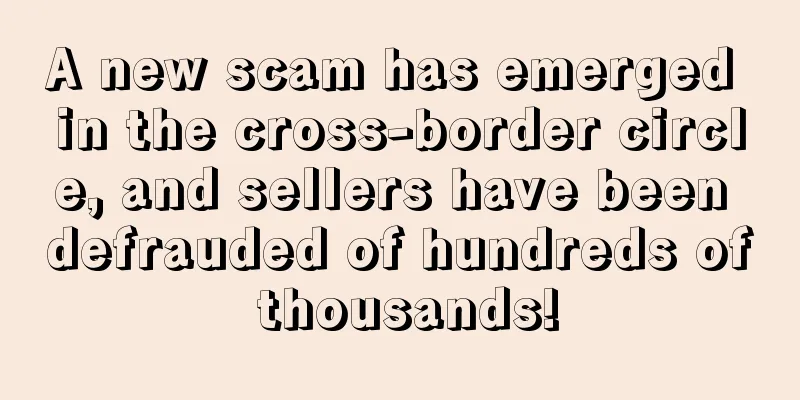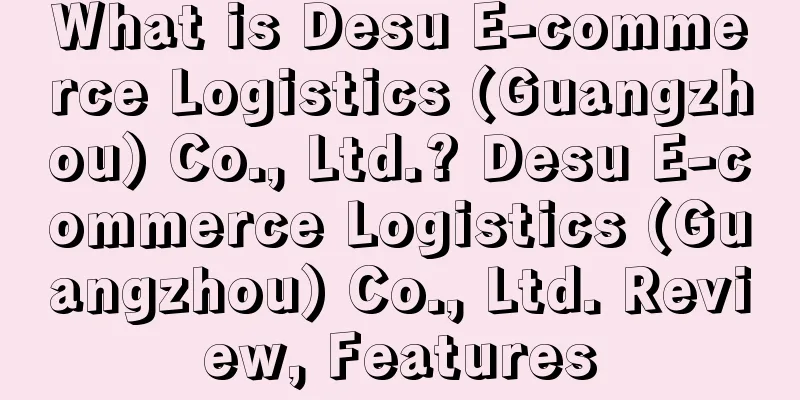A new scam has emerged in the cross-border circle, and sellers have been defrauded of hundreds of thousands!

|
Cross-border e-commerce scams emerge in an endless stream, making it difficult for sellers to guard against them!
Recently, another cross-border e-commerce scam was exposed.
Many people fell for the “ no source model ” cross-border e-commerce scam !
Many more people fell for the cross-border e-commerce scam of the " no source model " and were defrauded of hundreds of thousands of dollars .
It is understood that scammers will publish a large number of false advertisements to promote cross-border e-commerce with a " no source model " , claiming to provide free teaching, free platform, the ability to open a store without a source of goods, and high returns with low costs, in order to attract people who want to start a business with low cost.
Scammers attract sellers through advertisements, and after getting in touch with them, they will claim to be responsible for operational guidance, introduce the operational process to the sellers in detail, and require them to download a designated platform to complete the order taking, purchasing, delivery, cash withdrawal and other processes through the platform .
In order to gain the seller's trust, scammers will tell the seller that daily settlements will be made in US dollars .
After the seller completes the registration and store opening process under the guidance of the fraudsters, he or she can quickly receive the first order. At this time, the fraudsters begin their own routine, instructing the seller to pay the payment on the platform to complete the purchase and delivery, and then claiming that the payment made by the customer will be frozen in the platform account, and the funds can be withdrawn after the goods are confirmed to be received.
In the early stages, scammers will operate in the background to "create many orders" for the seller's store, creating the illusion that the store is booming with orders, in order to induce the seller to continue investing money to purchase goods.
When sellers invest more and more money and make more and more money from selling goods and want to withdraw money, there will be prompts such as "account abnormality" , "system maintenance" , "operation error" , etc., and the account will be directly frozen and the withdrawal will fail. When sellers want to solve the problem through various operations, they will be required to pay the unfreezing fee and handling fees, etc., and eventually they will get deeper and deeper into the trap, invest more and more money, and find out that they have been cheated.
Just last month, the seller Steven revealed that he was scammed by scammers and lost up to 700,000 yuan.
Steven said bluntly: " The platform is fake, the customers are fake, the orders are fake, and even the group members are fake ! "
Steven said that he saw the promotional scheme of "zero cost, low risk, high return , and no source of supply cross-border e-commerce " on the Internet , and contacted the scammer with the idea of giving it a try.
In order to gain trust, the scammer pulled Steven into a so-called communication group . In the group, Steven saw many successful cases of zero cost and high return, and couldn't help falling into the scammer's trap.
The scammers induced Steven to use a specific APP to log in to a fake "cross-border e-commerce" platform , and then register an online store to quickly obtain orders.
The scam was similar to the one mentioned above. After a large amount of money was deposited into the scammer's account, the scammer blocked Steven's store on the grounds that he did not deliver the goods on time, and asked Steven to pay a deposit to unblock it. After Steven paid the deposit, there was no further news, and the communication group he joined at the beginning was also disbanded. Steven then realized that he had been cheated and that all the group members were "dragers".
Another seller was also severely harmed and was defrauded of nearly 650,000 yuan!
Bernie , a seller in Inner Mongolia , reported to the police that he was defrauded of hundreds of thousands of yuan from the end of 2023 to the beginning of January this year when he opened a "cross-border online store".
At that time, Bernie accidentally saw an advertisement that offered free promotion for opening a cross-border online store while surfing the Internet, and believed it to be true. After adding the other party's WeChat, Bernie downloaded the mobile APP from the URL sent by the other party, registered the online store, and started operating it.
At first, everything seemed normal. Bernie transferred the payment to the bank account designated by the scammer. After the "buyer" placed an order and signed for it successfully, the money from the sale was directly deposited into the platform's account, and Bernie could withdraw the money to his own bank card.
But not long after, everything changed. Bernie did not have enough funds to pay for the goods, and suddenly found that the funds in the platform account could not be withdrawn. Only then did he realize that he had been cheated and eventually lost about 650,000 yuan.
The " no-source model " cross-border e-commerce scam is very tricky
There are countless similar incidents, and the same routine is hidden behind them .
① Online platforms spread false advertisements
Scammers usually spread fake advertisements with keywords such as "zero cost, low risk, high return , no source of goods cross-border e-commerce " on online social platforms to attract sellers to click on the advertising link to contact them.
② Guide sellers to download the APP or log in to the designated website to register a store
After contacting the seller, the scammers will ask them to register a so-called cross-border e-commerce store, and even send fake official emails to the seller to gain the seller's trust.
③ The first order is successful and profitable and cash withdrawal makes the seller let down his guard
After the seller successfully registers the store, he will quickly get the first order, and then the scammer will guide the seller to the designated website to purchase the goods. After the order is completed, the seller will see the income in the account on the platform and can successfully withdraw the money, and gradually let down his guard.
④ The seller's order volume surges, and the seller continues to invest in purchasing goods
After the seller successfully lets down his guard, the store's order volume begins to increase rapidly. The scammer will then continue to ask the seller to pay the purchase fee on a designated website. The seller will then invisibly fall deeper and deeper into the scam.
⑤Continue the routine! Prohibit sellers from withdrawing cash and ask for a deposit
After the orders surged and a large amount of money was invested in purchasing goods, the seller thought he had made a fortune and wanted to withdraw the profits from the platform account. At this time, he would receive a "low credibility" prompt and the platform would refuse to withdraw cash. Only by paying a deposit or continuing to complete orders can the credibility be restored. Only then did the seller realize that he had been cheated.
These so-called " cross-border e-commerce platforms without sources of goods " are actually mostly fake websites set up by fraudsters . Generally speaking, their servers are located overseas, and the sales volume of platform transactions is modified by the fraudsters themselves in the background. In fact, there is no real transaction.
There is no free lunch in the world, and there is no business that is guaranteed to make money. Don't trust strangers on the Internet platform to avoid falling into a scam.
Is the “no-source model” credible?
The so-called "no source of goods" actually means that the seller only acts as an intermediary. In the daily operation process, he only needs to be responsible for taking orders, and the delivery will be completed by the manufacturer or other merchants.
If you choose the no-source model when opening an online store in China, the risk factor is relatively low because the source can basically be traced.
However, if you engage in cross-border e-commerce, you will need to bear certain risks, especially in the early stages you will need to pay deposits, guarantee fees, etc.
Moreover, before opening a store, you usually need to conduct market research abroad to understand the clear market demand, product pricing and tariffs, so as to determine the operation strategy. If you only need to open a store at home and wait for the money to come in, it is actually very unrealistic.
The "no source model" scam is hard to guard against. This scam is mostly aimed at novice sellers who have just entered the cross-border e-commerce industry. In addition, the scammers have tailored fake websites and fake information for the entire chain of e-commerce platforms, overseas warehouses, etc. , making it difficult for sellers to detect.
Here, the editor reminds sellers that when entering the cross-border e-commerce industry, they must identify official channels and not pursue low costs and high returns at the beginning , so as to avoid being deceived and incurring unnecessary losses. scam No source |
<<: Another company went bankrupt and was fined more than 300 million!
>>: An employee was caught reselling company goods!
Recommend
What is WaiPay? WaiPay Review, Features
WaiPay is a digital payment management system that...
What is CrsdoERP? CrsdoERP Review, Features
CrsdoERP can simultaneously monitor relevant infor...
What is Purple Carrot? Purple Carrot Review, Features
Purple Carrot is an American monthly vegetarian m...
700 new SKUs every day, it sells nearly 400 million in a quarter
In the past year or even two, the enthusiasm for ...
Brazil's e-commerce bonus! Children's products and cosmetics are the most popular
It is understood that in Brazil, the penetration ...
What is VCKOVCKO? VCKOVCKO Review, Features
VCKOVCKO is a store that specializes in false bear...
What is gruvgear? gruvgear Review, Features
gruvgear is a premium lifestyle accessories brand ...
Amazon to become UK's largest retailer by 2025
According to new research from Edge Retail Insigh...
Many sellers were banned for fake orders, and the punishment for manipulating reviews has changed again?
Seller’s quote: These days, if you haven’t had yo...
What is quatat-tattoo-supply? quatat-tattoo-supply Review, Features
quatat-tattoo-supply Tattoo Equipment Manufacturin...
With annual income exceeding 100 million yuan, big sellers such as Anker and Savi are betting on this track!
Are independent sites the future development tren...
It’s a shame that sellers’ “lost items” rate on Amazon is 27 times higher than other platforms
First, the other party has no way to provide defi...
What is Green Point Der Grüne Punkt? Green Point Der Grüne Punkt Review, Features
The Green Dot Der Grüne Punkt is a leading supplie...
Foreigners complained that the word "peanut" was printed incorrectly on the air fryer bought from Temu
Recently, a foreign consumer who bought an air fr...
Online GMV reaches $6.7 billion, Best Buy accelerates omni-channel transformation
Recently, Best Buy released its fourth-quarter re...









